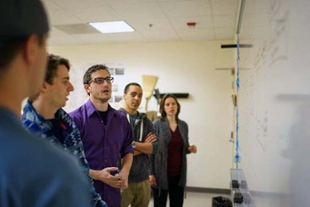Thinker
James Watkins ('17)
News
‘We’re mainly working with a group that is called XMC, which is Exploration Medical Capabilities. We’ve presented what we’re working on to NASA engineers from Langley and also to others who were linked up from all over the country.’
|
James Watkins ('17) Major: Highlights: |
Talk about this two-year-long capstone project.
We’re working to develop a cold plasma sterilization system for long-term space flight. What the issue is right now is that all of the small medical equipment that they fly — scalpels, forceps, those sorts of items — are one-time use, so everything that they fly up there has to be disposed after one use due to contamination. What we’re working on is a system that uses cold plasma to sterilize that medical equipment so that it can be re-used. That’s extremely important for a variety of reasons, including cost. To fly just into lower orbit, it costs $10,000 per pound of payload. For perspective, you could be looking at 200 kilograms of sanitation wipes that could be eliminated from the mix by having a system that allows you to sterilize without having to use these kinds of heavy things, so the potential for significant cost savings is very real. And that’s just at lower orbit, so a flight to Mars is going to be exponentially more expensive.
Is the project difficult?
It’s very challenging as far as all of the things that go along with working with a new technology that’s not in common use right now — the whole cold plasma thing —and then on top of that working with a large organization like NASA. We are getting such great experience from this.
(Related story: Engineering students embark on space travel project for NASA)

What’s your favorite engineering course so far?
I really enjoyed Statics and Dynamics. It was my introduction into applying in real situations all of the theoretical physics that you had looked at in all the previous JMU engineering classes. I found it fascinating. You could begin to see how all of the parts and pieces that you had spent your previous year looking at and learning about actually fit together as part of a particular system, both mathematically and physically. It was the first time when you got to apply all of the theoretical math we had been learning about to actual situations.
Talk about some of your other classes.
There’s a core engineering curriculum that you know about when you come in to the major, but then there’s also a lot of elective classes that come up. For example, I’m in a class called Interpersonal Innovations. It includes students from other majors, too. So I’m coming into a project working with nursing and biology majors, so it’s a seven-person collaboration project such as could possibly occur in real life. It’s really interesting to have all the different perspectives and viewpoints. We get to tackle a real-world problem — metabolic syndrome — and I get to learn to work with people who are not engineers.
Did you start at JMU in engineering?
I actually came to JMU for music. I was in vocal performance. I switched to engineering after my second semester here. My reasoning was that I stopped enjoying the vocal performance, and that I didn’t think that I wanted to spend all of my time doing something as an actual job if it was clear that I wasn’t going to enjoy doing it.
So why engineering?
I had taken engineering classes all throughout high school. I came to JMU with the idea that I would try the vocal performance track and see if it was something that I would be able to commit to and fall in love with and if not, then perhaps I could pursue engineering here instead. Engineering was a dramatic change. I wouldn’t call it easier — I have a great deal of respect for music majors. Engineering is so challenging. I think that’s part of why I like it so much.
What’s next?
I’m still finalizing what I want to do after graduation next year. Currently, I would like to work for a company that does work similar to what NASA is doing — especially when it comes to pushing boundaries and doing things that haven’t been done before.
